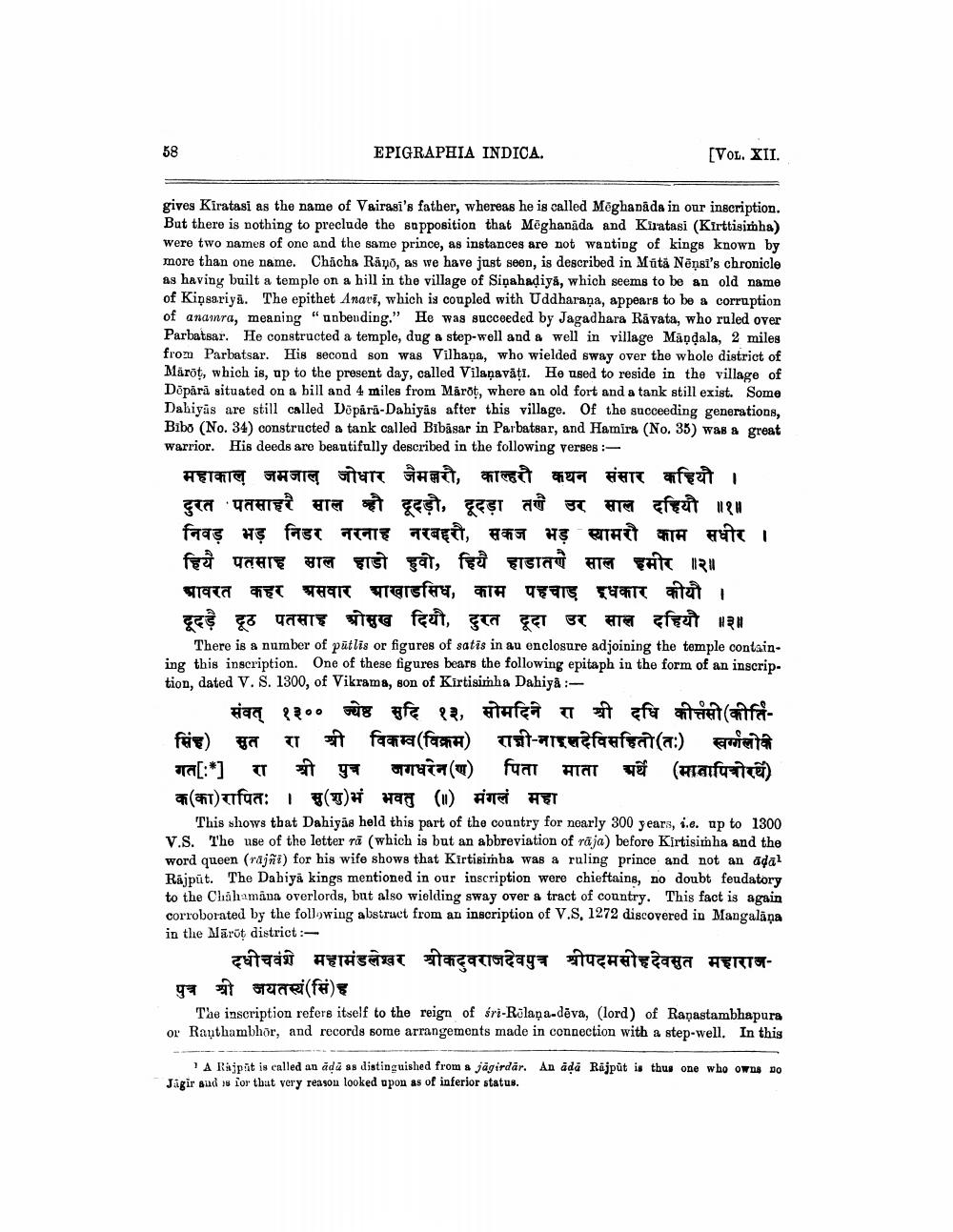________________
EPIGRAPHIA INDICA.
[VOL. XII.
gives Kiratasi as the name of Vairasi's father, whereas he is called Möghanada in our inscription. But there is nothing to preclude the supposition that Meghanada and Kiratasi (Kirttisinha) were two names of one and the same prince, as instances are not wanting of kings known by more than one name. Chacha Rayo, as we have just seen, is described in Mūtă Nēnsi's chronicle as having built a temple on a hill in the village of Sipahadiya, which seems to be an old name of Kiņsariya. The epithet Anavi, which is coupled with Uddharaṇa, appears to be a corruption of ananra, meaning " unbending." He was succeeded by Jagadhara Ravata, who ruled over Parbatsar. He constructed a temple, dug & step-well and a well in village Māodala, 2 miles from Parbatsar. His second son was Vilhana, who wielded sway over the whole district of Märöt, which is, ap to the present day, called Vilaņavāți. He used to reside in the village of Dopārā situated on a hill and 4 miles from Marot, where an old fort and a tank still exist. Some Dahiyas are still called Döpara-Dahiyās after this village. Of the succeeding generations, Bibo (No. 34) constructed a tank called Bibāsar in Parbatbar, and Hamira (No. 35) was a great warrior. His deeds are beautifully described in the following verses :
महाकाल जमजाल जोधार जैमलरी, काल्हरौ कथन संसार कहियौ । दुरत पतसाहरै साल हो दूदड़ी, दूदड़ा तणे उर साल दहियौ ॥१॥ निवड़ भड़ निडर नरनाह नरबद्दरी, सकज भड़ स्यामरौ काम सधीर । हियै पतसाह साल हाडो हुवी, हिये हाडातणे साल हमीर ॥२॥ पावरत कहर असवार पाखाडसिध, काम पहचाड इधकार कीयौ । दूदड़े दूठ पतसाह प्रोमुख दियौ, दुरत दूदा उर साल दहियौ ॥३॥
There is a number of pūtlis or figures of satis in au enclosure adjoining the temple containing this inscription. One of these figures bears the following epitaph in the form of an inscription, dated V. S. 1300, of Vikrama, son of Kirtisimha Dahiya :
संवत् १३०० ज्येष्ठ सुदि १३, सोमदिने रा श्री दधि कीत्तसी कीर्तिसिंह) सुत रा श्री विकम्ब(विक्रम) राजी-नारसदेविसहितो(तः) स्वर्गलोके गत[:*] रा श्री पुत्र जगधरेन(ण) पिता माता अर्थे (मावापित्रोरर्थ) क(का)रापितः । सु(शुभं भवतु (1) मंगलं महा
This shows that Dahiyas held this part of the country for noarly 300 years, i.e. up to 1300 V.S. The use of the letter rä (which is but an abbreviation of raja) before Kirtisimha and the word queen (rajñi) for his wife shows that Kirtisimba was a ruling prince and not an adal Rajput. The Dahiya kings mentioned in our inscription were chieftains, no doubt feudatory to the Chahamana overlords, but also wielding sway over a tract of country. This fact is again corroborated by the following abstruct from an inscription of V.S. 1272 discovered in Mangalapa in the Marit district:
दधीचवंशे महामंडलेश्वर श्रीकदवराजदेवपुत्र श्रीपदमसीहदेवसुत महाराजपुत्र श्री जयतस्थ(सिंह
The inscription refere itself to the reign of Sri-Rilapa-deva, (lord) of Rapastambhapura or Ranthambhor, and records some arrangements made in connection with a step-well. In this
JA Rajput is called an adà as distinguished from & jagirdar. An ada Rajput is thus one who owns Do Jagir audior that very reason looked upon as of inferior status.




